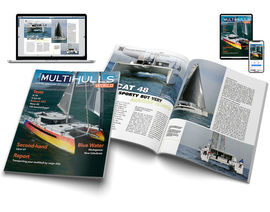Helia 44 for sell, ready to sail...
- Location :
- Le Marin, Martinique
- Year :
- 2015
Our position: 18°28’.9 S - 163°5’.555 E
The anchorage can be a little rolly, but the scenery is breathtaking. The biodiversity reminds us of the Chagos Islands, in the heart of the Indian Ocean. Here, as there, the animals don’t seem afraid of our presence. On the contrary, they are curious and watch our arrival. On these few square feet of land, a veritable colony of seabirds has established itself: boobies, frigate birds and other smaller species whose names escape me.
Access to the interior of the island is forbidden to protect these precious species, so we observe them from the sandy beach. The vegetation, although sparse, seems perfectly adapted to this avifauna, which has organized itself into a proper community. The gannets, the most numerous, occupy every square foot with their nests. Some still have eggs in them, others adorable chicks, while the young, larger than their mothers, sing in disorderly fashion as they molt, reminiscent of the carefree days of our own adolescence.
Underwater, the diversity of species is just as fascinating. The turquoise parrotfish are imposing, the loaches reach impressive sizes and the jacks are simply gigantic. We had already admired Surprise atoll, and now we were heading off along Huon islet.
As before, the strong current made anchoring difficult. The waves hit the starboard hull, making the mast sway. This rolling motion, which elsewhere would have forced us to look for another mooring, is incidental here when compared to the privilege of enjoying such an exceptional place. Once our anchor is firmly fixed in a sandy bottom, I let my mind wander, dreaming of the treasures that we might discover.
Shores that are exposed to the wind sometimes yield the ocean’s waste: toothbrushes, sandals and other human detritus. This time, it’s the tiny nautiluses, veritable marvels of nature, that prove to be our treasure.
The climate in and around New Caledonia is tropical, with two distinct seasons. From November to April, it’s hot and humid, with temperatures between 25 and 30°C, frequent rainfall and the risk of cyclones. The cyclone risk is even considered to be high, with a 20% probability of damage being observed over the next 10 years. As for the swell, it is sometimes strong, and the winds can change rapidly. May to October is the dry season, which is milder and sunnier. The south-east trade winds are well established and it’s the ideal time to get out of Noumea and discover this remote and beautiful region, even if the currents around the islets of Belep and Entrecasteaux remain strong.





What readers think
Post a comment
No comments to show.